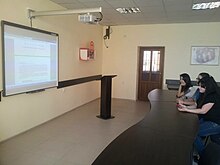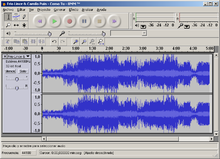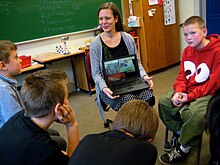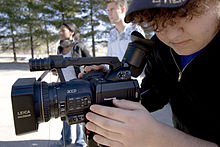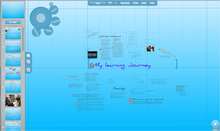Teaching medium
The teaching medium is a means of communication (medium) that is used in teaching for didactic purposes. These include school books , worksheets, notebooks , teaching software and educational films . In German-speaking countries, media didactics deals with the use of media in lessons .
Definition of terms
Teaching media are differentiated from:
- Educational media that, in addition to teaching media, also include media that are used outside of the classroom, e.g. for self-study
- Teaching and learning materials , which in addition to media also include typical school teaching materials such as sports equipment, musical instruments or laboratory equipment.
classification
Very different criteria can be used for the classification of teaching materials:
- An outdated distinction is that of “pre-technical” (book, school notebook, blackboard, etc.) and “technical” teaching media (film, sound recording, computer). This distinction is no longer supported by modern media didactics because many “pre-technical” and “technical” media do not differ at all with regard to their didactic function. For didactics it is z. For example, it hardly matters whether students look up a lemma in a printed or online encyclopedia.
- The same applies to the distinction between “conventional” (book, role film, photography) and “electronic” teaching materials (Internet, computer, tablet). Whether students z. Taking photos, for example, with a roll film camera or a smartphone is largely irrelevant for didactic considerations.
The greatest advantage of using teacher laptops, interactive whiteboards, and student laptops or tablets is the multi-functionality of these devices, i. H. in that they make specialized tools such as video recorders, overhead projectors, flash cards, etc. superfluous. Further advantages are that electronic teaching media can be easily produced by yourself and modified as required, and that they offer the possibility of exchanging between teachers and schools via the school intranet or the Internet, with no administrative effort and no waiting times. The biggest disadvantage is the high acquisition costs. - The distinction between “learning objects” (film, sound recording, etc.) and “aids” (television, tape recorder, etc.), which is still explained to prospective teachers, is trivial and does not provide any information about which media are suitable for which teaching purposes .
- For didactics, it is more useful to distinguish between the dimensions of perception to which teaching materials can often be assigned, such as B. "visual", "auditory" and "audiovisual" teaching media.
- It is also useful to distinguish between the intended use. Some media are primarily suitable as resources, others for presentations (teacher lecture, student lecture), others for exercises and exams, and still others finally for the documentation or reference of what has been learned.
resources
text
In elementary school and foreign language lessons, texts are used to practice reading; In literature and advanced foreign language classes, texts (mostly fiction ) are read in order to apply the methods taught in class. In general, texts are used in schools to impart knowledge and as starting material for a variety of applications such as B. Exercises used. Text can be made accessible in class in many ways, including:
- handwritten notes on short texts on the blackboard , on the whiteboard or on a poster
- Projection of short texts using an overhead projector on a wall or screen (obsolete)
- shorter texts typed with a typewriter and then reproduced with a matrix printer (widespread until the 1990s)
- printed, digital or online books , e.g. B. fictional literature , school books , textbooks , manuals , reference works , non-fiction books ; Photocopies or screenshots of such resources.
- printed, digital or online periodicals , e.g. B. newspapers or magazines ; Photocopies or screenshots of such resources
- Text files ; Websites , including school and teacher websites
- Digital texts can be read on the laptop, on the tablet or on the e-book reader or output on the interactive whiteboard. One advantage of using digital texts is that they can be edited as desired, e.g. B. compiled , corrected, revised or formatted . Digital texts and the like can be won. a. by copying or taking screenshots of existing digital texts, by processing text scans with text recognition software and by typing them into the computer. When using texts that you have not written yourself - as always when using other texts - the copyright must be observed. Compared to writing on paper, the use of word processing software has the advantage that the text can be revised extremely easily; This means that orthographic corrections can be made, wording and sentence structure can be changed, sentences deleted or newly inserted, which often benefits the text architecture, while handwritten texts tend to have to be composed in the head in advance.
volume
Texts can also be made available to the students in spoken form:
- Read out
- Audiobooks can be played as a CD on the CD player , as a compact cassette (obsolete) on the cassette recorder and as an audio file (e.g. MP3 ) on the laptop, tablet or MP3 player , depending on the teaching situation, even with headphones . Digital audio books are available in many libraries; Partly for a fee, partly free of charge, they can also be downloaded from various online providers. There are also initiatives on the Internet such as Talking Books , for which voluntary speakers read in books for which copyrights no longer exist as audio files and make them available for free download.
Sound media are also z. B. also used in music and foreign language lessons. In subjects such as German or history, they can be used to e.g. B. to play historical audio documents. In other subjects, too, such as biology, numerous possible applications can be described. Audio documents can be made accessible in the classroom using a variety of techniques, including:
- Playing records on a turntable , playing tapes on a tape recorder , playing compact cassettes on a cassette recorder (all out of date)
- Playing CDs on a CD player
- Playback of audio files (e.g. MP3 ) on the interactive whiteboard, laptop, tablet or MP3 player , also with headphones depending on the classroom situation .
The use of digital audio files enables students and teachers to edit them with audio editing software such as B. to edit Audacity arbitrarily, so z. B. compiling compilations or mixing multiple audio tracks. Digital audio material can be obtained, among other things, by converting (possibly with the help of a special device) from non-digital media, by recording with a microphone (also with the built-in microphone, e.g. of a laptop or tablet) or by means of sound-generating software such as e.g. . B. virtual musical instruments or music notation programs . When ripping CDs, recording YouTube videos and in general when converting and copying all audio media that you did not create yourself, you must observe copyrights, even for non-commercial use. Student audios can be presented in class, uploaded to a website, or given to the teacher as homework or performance assessment.
image
Static images (photos, graphics) can be presented in class in many forms and with the help of a variety of techniques, such as:
- Paint simple graphics on the board or whiteboard
- Paper image, e.g. B. Poster or book illustration
- Projection with the episcope (obsolete)
- Slide (obsolete)
- Projection of graphics via overhead projector (obsolete)
- Output of digital images from the teacher's laptop via a projector to a canvas or wall
- Output of digital images from the teacher's laptop to the interactive whiteboard
- digital images on student laptops or tablet computers
The use of digitized images offers students and teachers the opportunity to edit them with image editing programs such as B. GIMP to edit as desired, such as making cutouts or adding text to images. Digitized images can be used by students and teachers in slide shows , presentations , on websites, and in countless other types of documents. Digitized images can be obtained by scanning , photographing, copying or screenshots of Internet images or by making your own with the help of graphics software such as B. Inkscape .
The animated series of instructional images , which anyone interested in IT can easily create themselves with the help of graphics software, is a transition form between static images and animated films .
Movie
Films can be presented in class in many forms and using a variety of techniques, such as:
- Projection of optical roll films via a film projector onto a screen (obsolete)
- Output of a DVD , Blu-ray Disc or video cassette via a DVD player or video recorder to a television set or via a projector to a screen
- Output of a locally stored video file (e.g. in MP4 format) or a video retrieved online (e.g. from YouTube , an online video library or a video-on-demand provider) ...
- on student laptops or tablets
- from the teacher's laptop to a projector on a wall or screen
- from the teacher's laptop to the interactive whiteboard
The use of digital film material offers students and teachers the opportunity to edit videos with video editing software (example: Windows Movie Maker ) as desired, e.g. B. to compile film sequences according to the respective needs, or to subtitle films or to provide an additional soundtrack. Videos that were created without infringing copyrights can also be put online if desired, e.g. B. on YouTube. Digital film material can be obtained by converting non-digital film or video material, possibly with special equipment ( film scanner , frame grabber ) or by copying online film material with screen recording software, although copyrights must be observed. Digital film material can be created by filming your own (with a digital camera , tablet computer or smartphone ) or by creating it with animation software (example: Blender ) without any conflicts with copyright .
Models
Under models are understood - usually three-dimensional - real or virtual representations of objects whose presentation of either is not possible in the original or in the classroom would not be instructive. Real, physical models have traditionally been part of teaching material collections. In countries of the western world , models are also made by students today, both in class and e.g. B. at Science Fairs .
Conventional model (a jellyfish, Blaschka glass model )
Virtual model (the front skull of the human)
Student work ( DNA )
Interactive media
Interactive media are used particularly in areas in which skills are to be practiced , learning material is to be deepened through queries, or many smaller tasks are to be completed in a single session, e.g. B. Math problems or exercises in foreign language lessons. Interactive media also play a central role in tests, class work and written exams, but also in homework . Interactive media include the following types and techniques, among others:
- text and / or graphic based
- printed or handwritten worksheets for experimental science lessons
- printed or handwritten exercise sheets
- printed exercise books and exercise books
- printed examination papers
- Exercise software. Schools in the United States have widely used electronic tools in foreign language teaching , such as the Conjuguemos web portal, which enables students to practice conjugating irregular verbs. The teachers can e.g. B. as homework, give up certain tenses of certain verbs , set a completion date and later check online whether and with what success the task was completed.
- Examination and evaluation software
- sound-based (possibly with text completion)
- multimedia (combinations of text, image, sound and / or film)
- Teaching and learning software , e.g. B. Language Learning Software; If the appropriate software is available, things like drawing letters can be practiced by beginners on the tablet computer. For foreign language lessons, videos can be used e.g. B. can be equipped with a web form in which the students complete tasks that are submitted to the teacher online.
Conventional interactive media, d. H. those that are filled out by hand by the students usually create a considerable need for follow-up work on the part of the teacher ( exam correction ), while the corresponding software immediately detects errors.
Further examples of interactive media can be found in the area of mobile learning , where teachers are often no longer used at all. The NetEnquiry project funded by the Federal Ministry of Education and Research, for example, enables simulated practical applications in the in-company training and further education of specialists and managers (subject: economy).
Presentation media
Teacher lecture and student presentation can be supported by a wide variety of media, including:
Special presentation software is also available for multimedia presentations , such as B. Microsoft PowerPoint or Prezi ; Nowadays, such programs usually allow the integration not only of graphics or photos, but also of sound and film. The presentation takes place either on the teacher's laptop (projector or interactive whiteboard) or directly on the student's laptops or tablets. Some applications, such as SlideShare , are web-based; Presentations that are created here can also be made publicly accessible if desired.
Documentation and construction media
In many subjects, the documentation of work performance and learning materials by the student takes a large part. The documentation is done partly to make learning material look up for the student, partly as homework, partly for examination purposes (e.g. as a school essay ). In the context of constructivist didactics , which conceives learning not as a reception but as a construction of information, the self-production of learning materials by the student is also understood as an independent learning process.
Conventionally, this is done with media such as:
- Exercise books , notebooks , spiral-bound notebooks, filing and loose paper
- Flashcards
Where student laptops or tablets are available, the documentation can also be electronic, i.e. H. in the form of text files . If the appropriate software is installed, tablets and laptops with touchscreens can even record handwritten text, sketches and more. Pen computing , d. H. Writing with the stylus on a touchscreen can also be preferable to typing on the keyboard for purely practical reasons: in the Bavarian Abitur exams, for example, typing with the keyboard is not allowed because this would save the student time. In addition to the pure text, image, sound and film elements can also be used in electronic text documentation. Homework, projects and similar electronic documentation can be submitted via email or tools such as Google Classroom or set up in the form of websites. At the private grammar school in Neubeu , one of the few general education schools in Germany that has already implemented integrated learning comprehensively, digital teaching media are organized with the help of Microsoft OneNote software and are kept permanently available.
See also
Individual evidence
- ↑ Köck, Peter: Handbuch der Schulpädagogik (ebook) for study - practice - examination (all grades) . 1st edition. Augsburg, ISBN 978-3-403-33480-4 , p. 370 .
- ^ Ingbert von Martial, Volker Ladenthin: Media in teaching. Basics and practice of media didactics , Hohengehren, 2002
- ↑ Talking Books on YouTube. Retrieved December 12, 2015 .
- ^ Margaret Ramirez: What it Really Takes for Schools to Go Digital. In: Time. August 28, 2014, accessed February 25, 2018 . Amy Buttner: Activities, Games, and Assessment Strategies for the World Languages Classroom . Routledge, New York, London 2007, ISBN 978-1-138-82729-5 , pp. 8 ( limited preview in Google Book search). Deborah Blaz: Differentiated Instruction: A Guide for World Language Teachers . 2nd Edition. Routledge, New York, London, ISBN 978-1-138-90618-1 , pp. 8 ( limited preview in Google Book search). Conjuguemos.com. Retrieved February 25, 2018 .
- ↑ NetEnquiry. Retrieved February 26, 2018 . Marc Beutner, Marcel Gebbe: Serious Mobile Learning. More than the use of mobile devices . In: Marc Beutner (Ed.): NetEnquiry. Innovative approaches to serious mobile learning for training and further education . Ingenious Knowledge, Cologne 2016, ISBN 978-3-946826-00-2 , p. 41-69 .
- ↑ a b Anja Reiter: guinea pig. In: The time. January 23, 2019, accessed February 6, 2019 .
literature
- K. Boeckmann, N. Heymen: Design your own teaching media . Handbook for School and Classroom Practice. Neuwied 1990.
- Bardo Herzig (Ed.): Media make school. Basics, concepts and experiences in media education . Bad Heilbrunn 2001
- Werner Sacher: Teaching-learning processes with media and original objects. In: Bardo Herzig (Ed.): Media make school. Basics, concepts and experiences in media education. Bad Heilbrunn 2001, pp. 109–128
- Detlev Leutner, Roland Brünken (ed.): New media in teaching, training and further education. Current results of empirical research. New York - Munich - Berlin 2000
- Roland Brünken, Susan Steinbacher, Detlev Leutner: Spatial imagination and learning with multimedia. In: Detlev Leutner, Roland Brünken (Hrsg.): New media in teaching, training and further education. Current results of empirical research. New York - Munich - Berlin 2000
- Günter Helmes : From views of faces to insights? Portraits of Joseph von Eichendorff, Rio Reiser and Wolfgang Borchert in a school book for grade 8 . In: Franz Billmayer , Manfred Blohm (Hrsg.): Schulbuchbilder. Image skills acquisition using the example of school books. Flensburg 2012, pp. 65–79. ISBN 978-3-939858-23-2 .
Web links
- http://www.zum.de : Central for teaching media on the Internet e. V.
- Teaching media for student-oriented teaching in .notebook format
- Jeannette Otto: This is where the end of the Cretaceous begins. In: The time. June 6, 2018, accessed on June 24, 2018 (on the introduction of digital media at a Freiburg grammar school).
